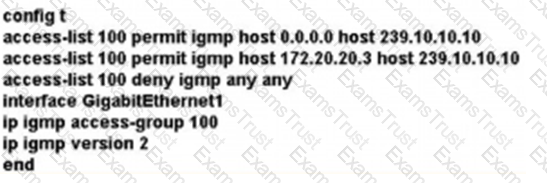Simulation 5
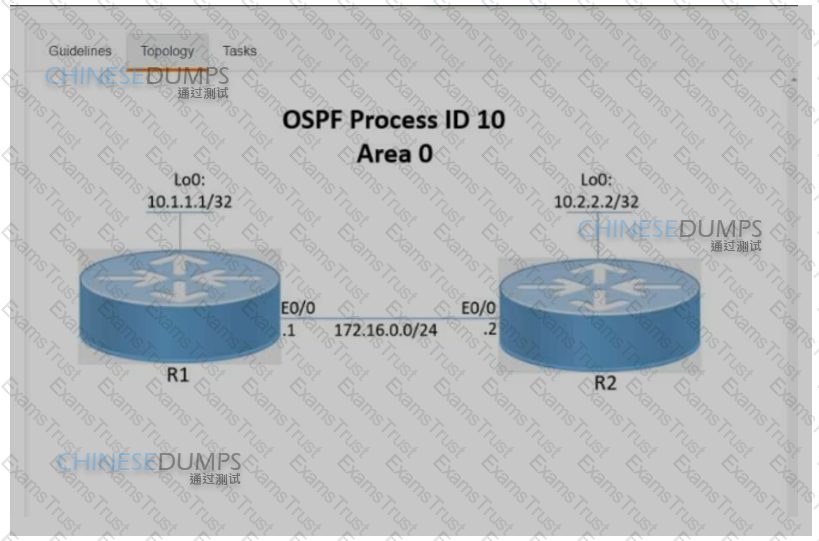
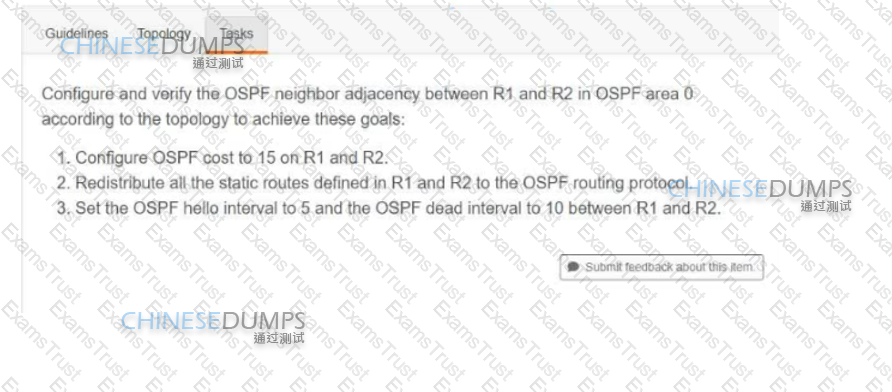
What is the role of NSO?
What does DWDM use to combine multiple optical signals?
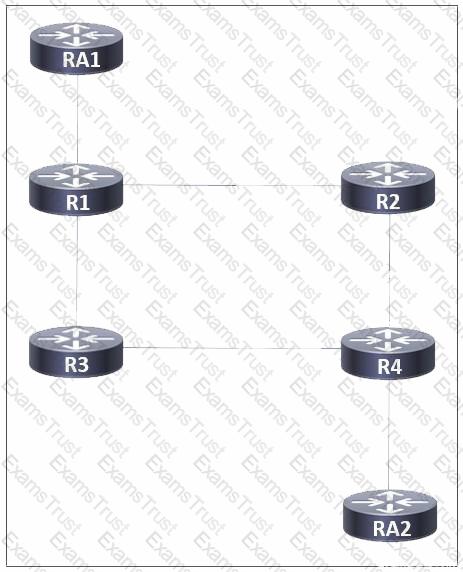
Refer to the exhibit. A network administrator implemented MPLS routing between routers R1, R2, R3, and R4. AToM is configured between R1 and R4 to allow Layer 2 traffic from hosts on RA1 and RA2. A targeted MPLS session is established between R1 and R4. Which additional action must the administrator take on all routers so that LDP synchronization occurs between connected LDP sessions?
You are configuring MPLS traffic-engineering tunnels in the core.
Which two ways exist for the tunnel path across the core? (Choose two )
Which OS uses a distributed subsystem architecture?
Which fact must a network engineer consider when planning to deploy RSVP-TE FRR?

Refer to the exhibit. Tier 2 ISP A on AS 653 is connected to two Tier 1 ISPs on AS 321 and AS 51 respectively. The network architect at ISP A is planning traffic flow inside the network to provide predictable network services. Cisco Express Forwarding is disabled on the edge router. How should the architect implement BGP to direct all traffic via the Tier 1 ISP with next-hop 7.4.5.2?
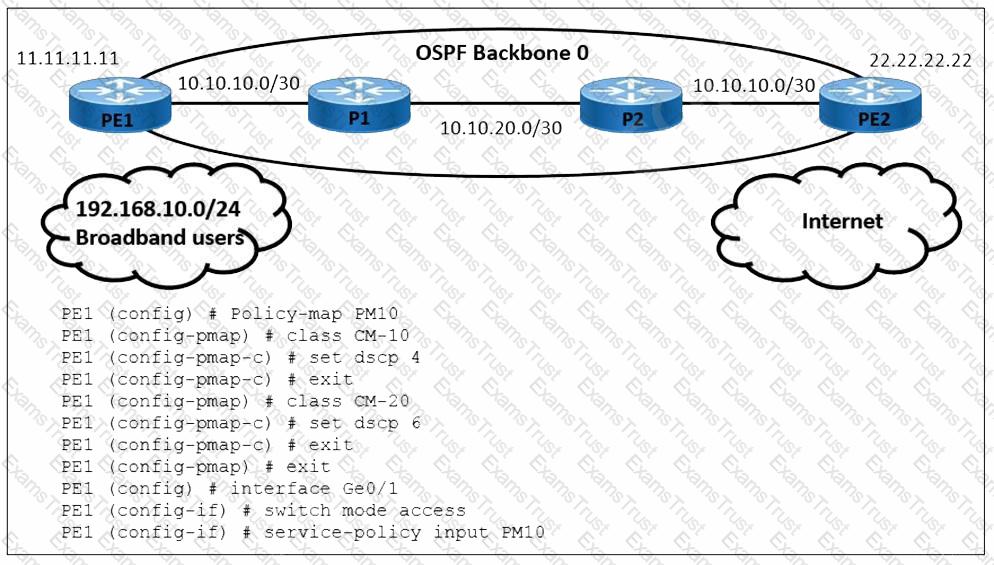
Refer to the exhibit A user is performing QoS marking on internet traffic and sending it with IPv4 and IPv6 headers on the provider edge device PE1. IPv4 traffic is classified with DSCP 4 and IPv6 traffic is classified with DSCP 6. Which action must the engineer take to begin implementing a QoS configuration on PE1 for the IPv6 traffic?
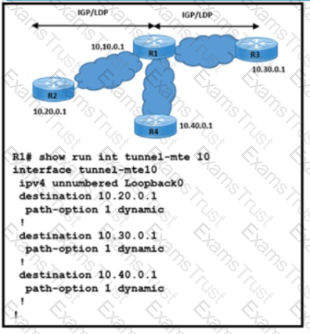
Refer to the exhibit. An engineer must Implement a traceroute operation to verity the R1 point-to-multipoint LSP connections. The traceroute operation must return all labels and hop-by-hop IP addresses for destinations 10.20.0.1. 10.30.0.1, and 10.40.0.1. and the maximum number of hops is 4. Which command must be executed to meet the requirements?
Refer to the exhibit.

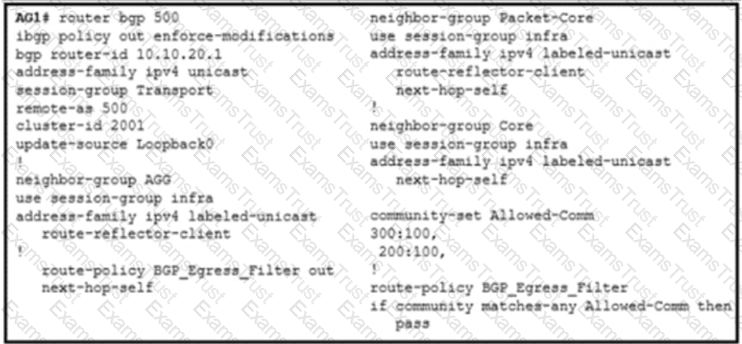
A NOC engineer is configuring label-based forwarding from CSR to the EPC gateway. Cell-site operation and maintenance for IPv4 traffic between 10.20.10.1 and 192.168.10.10 is already up. CR1 and CR2 are configured as route reflectors for AG1 and AG2. Which action completes the configuration?
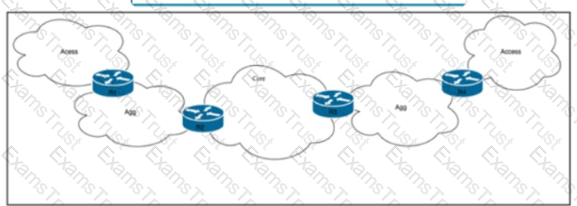
Refer to the exhibit. Tier 1 ISP A purchased several Tier 2 ISPs to increase their customer base and provide more regional coverage. ISP A plans to implement MPLS services in the access layer, with scalability up to 100.000 devices In one packet network and service recovery up to 50 ms. The network architect decided to use different independent IGP and LDP domains and interconnect LSPs that are based on RFC 3107. Which two actions must the network engineer perform to meet the requirements? (Choose two.)
Refer to the exhibit.

An engineer is securing a customer's network. Which command completes this configuration and the engineer must use to prevent a DoS attack?
A network administrator is planning a new network with a segment-routing architecture using a distributed control plane. How is routing information distributed on such a network?
A network engineer is deploying VRF on ASBR router R1. The interface must have connectivity over an MPLS VPN inter-AS Option AB network. Which configuration must the engineer apply on the router to accomplish this task?
A)

B)

C)

D)

What are two features of stateful NAT64? (Choose two.)
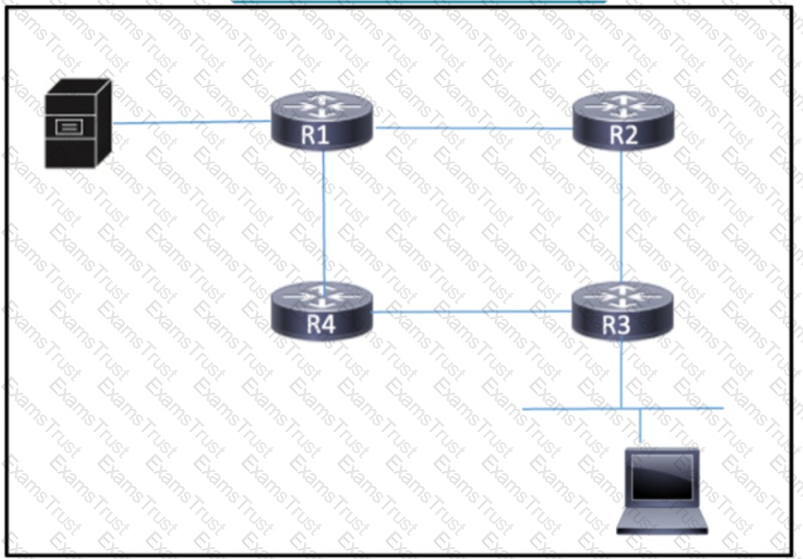
Refer to the exhibit. A host connected to R3 must connect with a server on R1 that provides critical, time-sensitive data. Traffic between the host and server must always be given bandwidth to traverse the links when they are congested, with other traffic being dropped. How must the network engineer implement a QoS strategy with classification to ensure that the traffic is given the appropriate bandwidth?
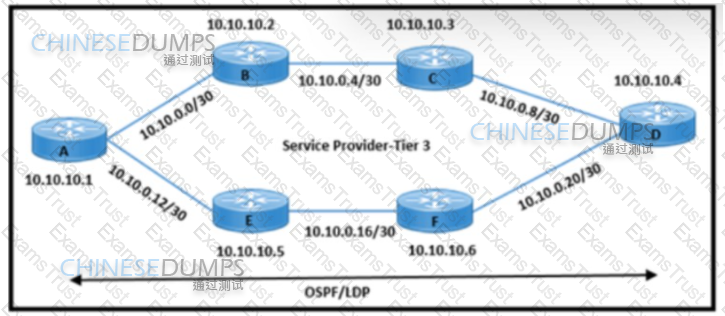
Refer to the exhibit. An engineering team must update the network configuration so that data traffic from router A to router D continues in case of a network outage between routers B and C. During a recent outage on the B-C link, the IGP traffic path was switched to the alternate path via routers E and F. but label forwarding did not occur on the new path. Which action ensures that traffic on the end-to-end path continues?
Refer to the exhibit.
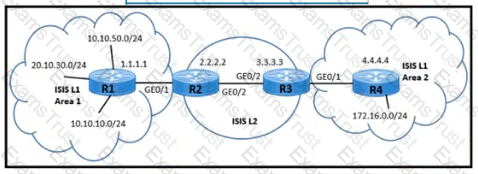
A network engineer must meet these requirements to provide a connects, solution:
Which two configurations must be implemented to meet the requirements? (Choose two)
Refer to the exhibit:
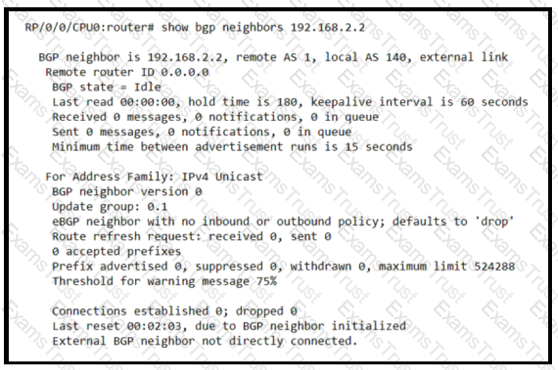
Based on the show/ command output, which result m true after BGP session is established?
Refer to the exhibit:

Which command is used to complete this configuration for QoS class-based marking?
Refer to the exhibit:
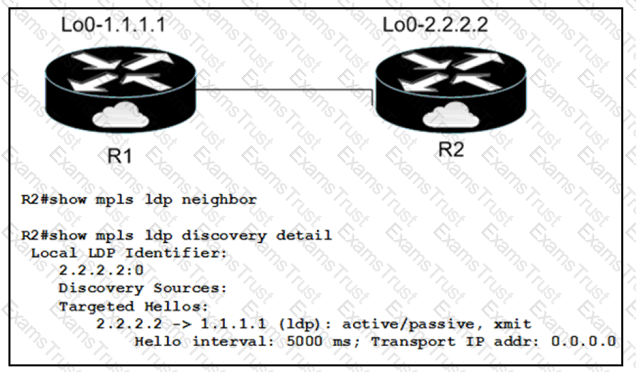
When implementing an LDP protocol, an engineer experienced an issue between two directly connected routers and noticed that no LDP neighbor exists for 1.1.1.1.
Which factor should be the reason for this situation?
A company needs to improve the use of the network resources that is used to deploy internet access service to customers on separate backbone and internet access network. Which two major design models should be used to configure MPLS L3VPNs and internet service in the same MPLS backbone? (Choose two.)
An engineer Is implementing NSR with OSPF on a large campus that requires high availability. Which task must an engineer perform to complete the process with minimal disruption to traffic?
Refer to the exhibit.

An engineer implemented OSPF neighbor relationship on an IOS device. Which configuration must be applied to get the OR/BOR election removed from interfaces running OSPF?
What Is the primary role of Ansible In a network?
Which protocol does a Cisco MPLS TE tunnel use to maintain paths within the core?
A network engineer is configuring a router to send multicast traffic for the 239.10.10.10 group. Which configuration must an .... forward the traffic?
What is the role of NFVI?
Drag and drop the characteristics from the left onto the corresponding radio splitting approaches on the right
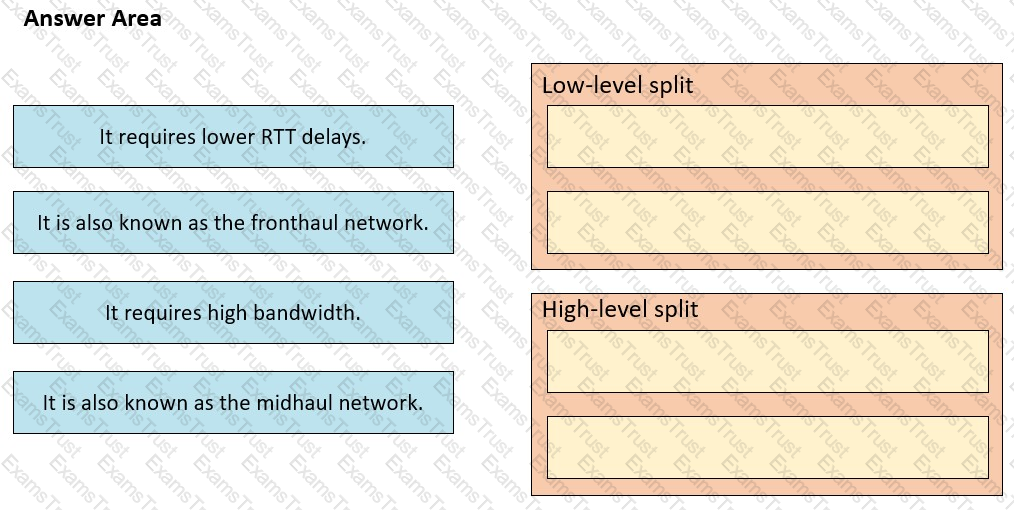
Refer to the exhibit.
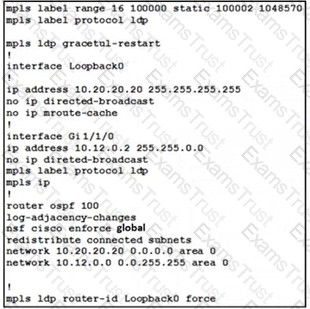
A network administrator implemented MPLS LDP changes on PE-A LSR device. The engineer must ensure there are no LDP peer are fully operational. Which LDP feature must the engineer apply to the existing configuration to eliminate the problem?
Which additional feature does MPLS DiffServ tunneling support?
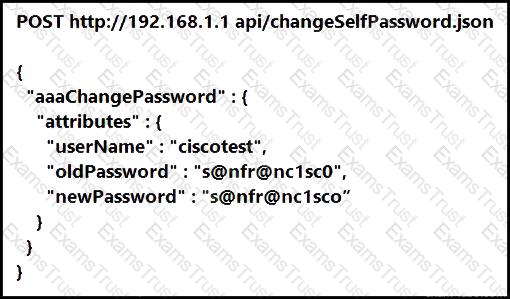
Refer to the exhibit. What is the purpose of this JSON script?
Drag and drop the methods of Cisco MPLS TE tunnel traffic assignment from the left onto their characteristics on the right.

Refer to the exhibit.
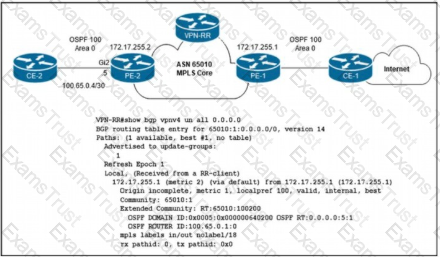
The network engineer who manages ASN 65010 is provisioning a customer VRF named CUSTOMER-ABC on PE-2. The PE-CE routing protocol is OSPF Internet reachability is available via the OSPF 0 0 0.0/0 route advertised by CE-1 to PE-1 In the customer VRF Which configuration must the network engineer Implement on PE-2 so that CE-2 has connectivity to the Internet?
A)
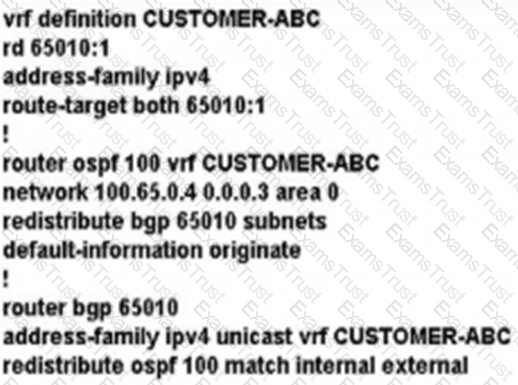
B)
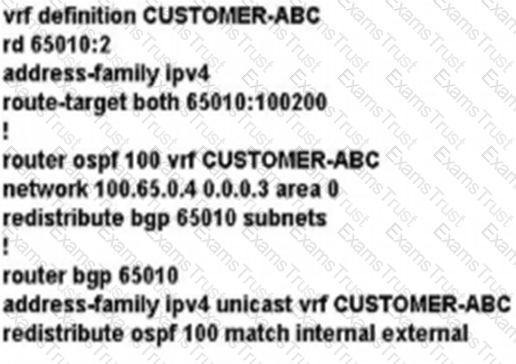
C)
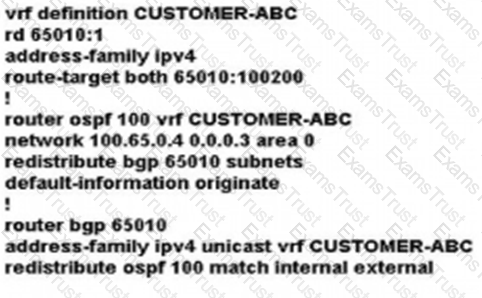
D)
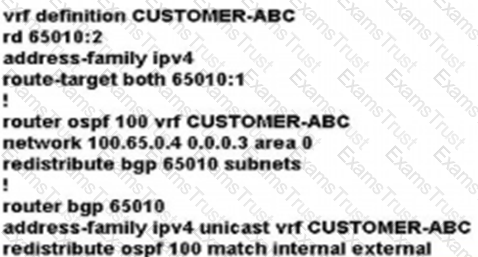
After a possible security breach, the network administrator of an ISP must verify the times that several different users logged into the network. Which command must the administrator enter to display the login time of each user that activated a session?
The NOC team must update the BGP forwarding configuration on the network with these requirements:
BGP peers must establish a neighborship with NSF capability and restart the session for the capability to be exchanged after 120 seconds.
BGP peers must delete routes after 360 seconds of inactivity.
Which action meets these requirements?
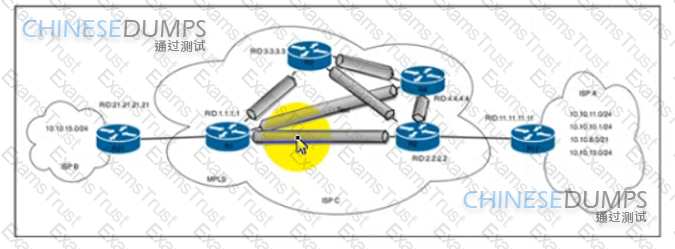
Refer to the exhibit An engineer at ISP C is configuring a new interconnection with ISPs A and B using the BGP protocol After the initial configuration the engineer noticed high memory usage and an abnormally large LIB table on router R2 Which two actions must the engineer take on R2 to minimize memory usage? (Choose two.)
Refer to the exhibit.

Which type of DDoS attack will be mitigated by this configuration?
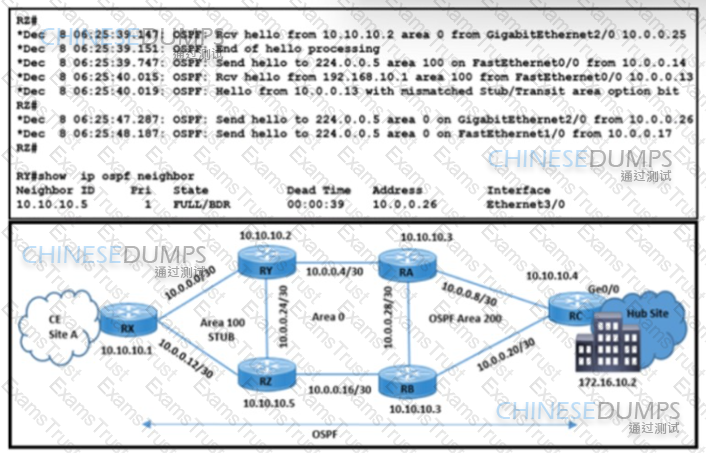
Refer to the exhibit. A network engineer received a complaint about these problems in OSPF stub area 100:
Which action resolves these issues?
What are two characteristics of MPLS TE turrets? (Choose two)
Refer to the exhibit.
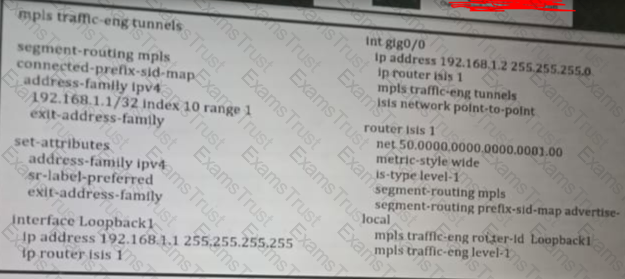
What type of configuration is it?
What is a role of NSO?
Refer to the exhibit:
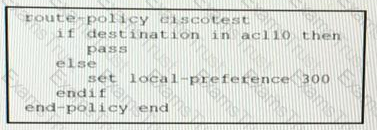
A network engineer is implementing a BGP routing policy.
Which effect of this configuration is true?
ASN 65001 is peering with ASN 65002 to exchange IPv6 BGP routes. All routes that originate in ASN 65001 have a standard community value of 65001:100, and ASN 65002 is allowed to advertise only 2001 :db8:aaaa::/48. An engineer needs to update the ASN 65001 route-filtering configuration to meet these conditions:
* Looped routes into ASN 65001 and routes that have traversed 10 or more ASNs must be denied.
* Routes accepted into ASN 65001 must be assigned a community value of 65001:200.
Which configuration must the engineer apply to the ASN 65001 border router?
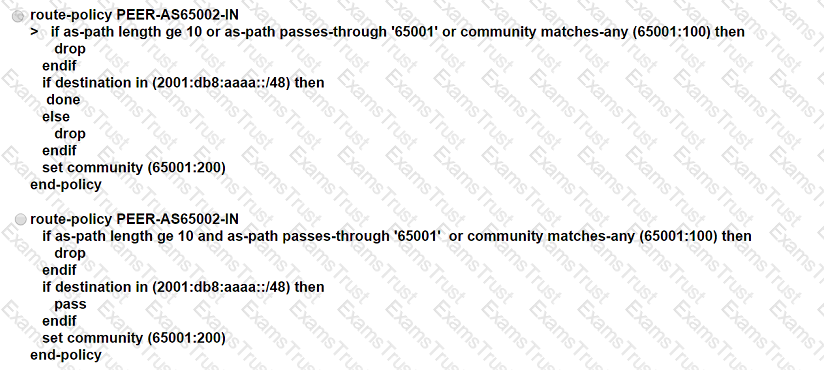
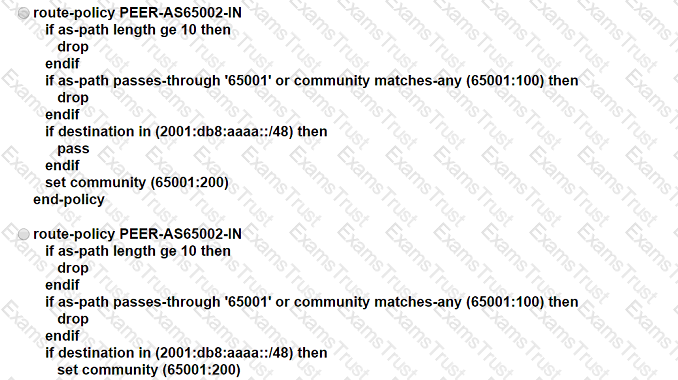
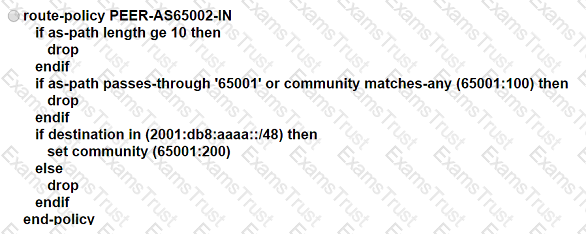
Refer to the exhibit:

What is significant about the number 2 in the configuration?
Refer to the exhibit.
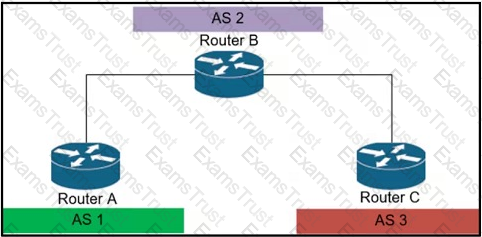
An engineer working for private Service Provider with employee id: 3948:11:613 is configuring the BGPsec framework. Which two conditions must the engineer take into account? (Choose two.)
What is the primary role of a BR router in a 6rd environment?
Refer to the exhibit.
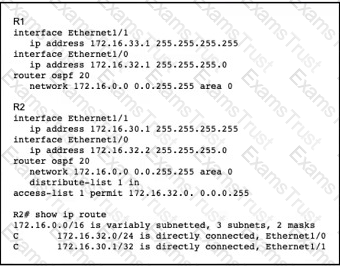
A network engineer notices that router R2 is failing to install network 172.16.33.1/32 in the routing table. Which configuration must the engineer apply to R2 to fix the problem?
Refer To the exhibit.
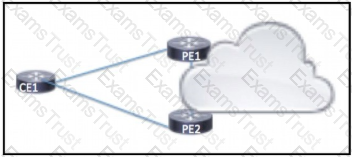
Which BGP attribute should be manipulated to have CE1 use PE1 as the primary path to the Internet?
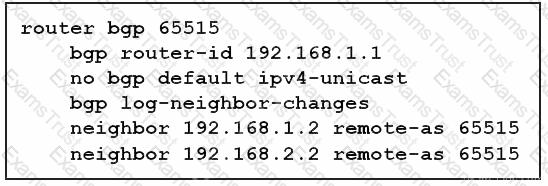
Refer to the exhibit. A network engineer is configuring a new router for iBGP to improve the capacity of a growing network. The router must establish an iBGP peer relationship with its neighbor. The underlay network is already configured with the correct IP addresses. Which step should the engineer apply to complete this task?
An engineer working for a private service provider with employee id: 3994 37 650 is configuring a Cisco device to redistribute OSPF into BGP. Which task enables the device to filter routes?
The network team is planning to implement IPv6 on the company’s existing IPv4 network infrastructure. The network currently uses IS-IS to share routes between peers. Which task must the team perform so that IS-IS will run in multitopology mode on the updated IPv6 network?
Refer to the exhibit.
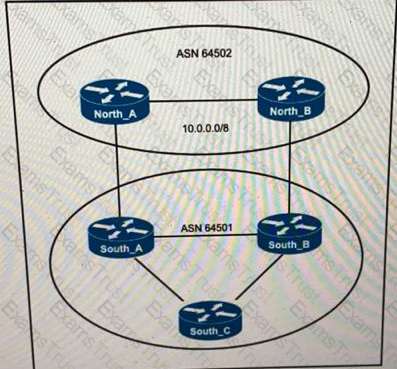
ASN 64501 currently reaches the networks under the 10.0.0.0/8 prefix via the North_B router, which is a slow backup link. The administrator of ASN 64502 wants traffic from ASN 64501 to 10.0.0.0/8 to travel via the primary link North_A. Which change to the network configuration accomplishes this task?
A router is advertising multiple networks to its BGP neighbor in AS 5200 with peer IP address 1.1.1.1. Which configuration must be applied so that the router permits updates only for networks with a prefix mask length less than or equal to 21?
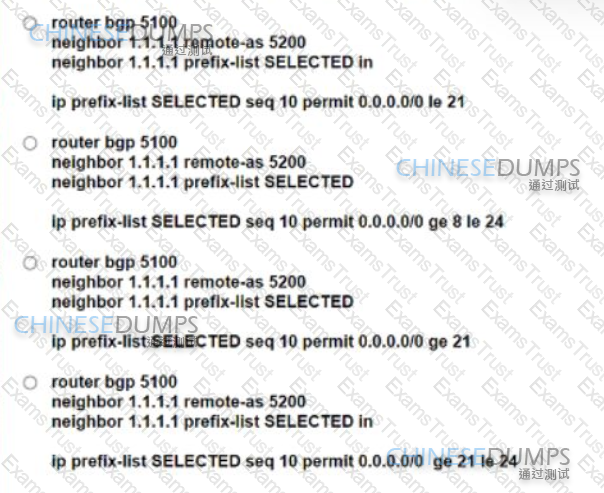
Refer to the exhibit. An organization s network recently experienced several significant outages due to device failures. The network administrator just moved the network devices to a new central data center, and packets are switched using labels. The administrator Is now implementing NSF on the network to reduce potential risk factors in the event of another outage. Which task must the administrator perform on each router as part of the process?

Drag and drop the characteristics from the left onto the automation tool on the right.
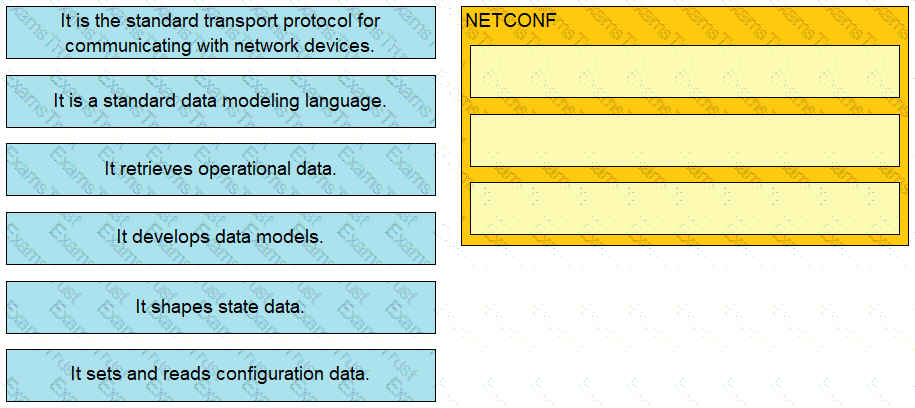
Refer to the exhibit.
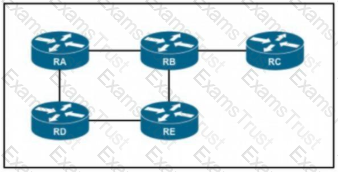
If RC is a stub router, which entry must be injected so that it will send traffic outside the OSPF domain?
Which characteristic describes prefix segment identifier?
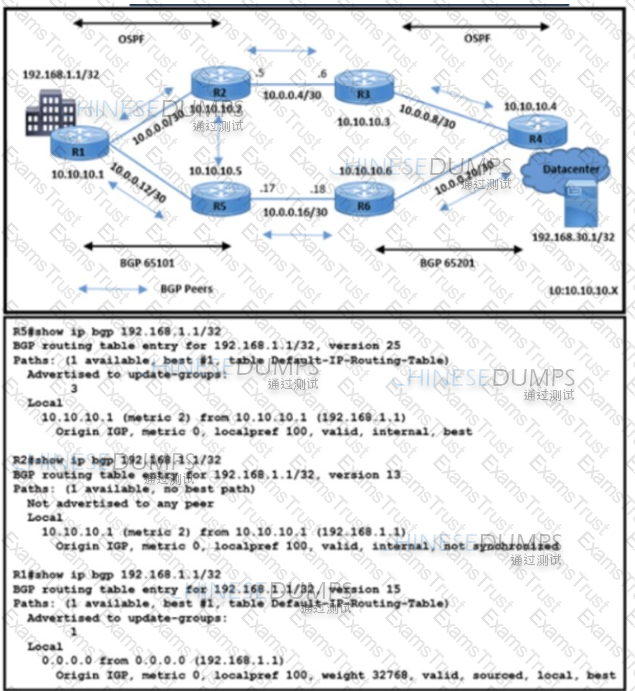
Refer to the exhibit. All BGP peering in AS 65101 and 65201 is enabled. The operations team is told that traffic destined to 192.168.1.1/32 from R4 does not use the path R3-R2-R1 as expected. An engineer debugs the issue and determines that 192.168.1.1/32 is advertised in the BGP routing table on R1. Which action resolves the issue?
Refer to the exhibit:

Which statement describes the effect of this configuration?
Refer to the exhibit A network engineer is in the process of implementing IS-IS Area 1 and Area 2 on this network to segregate traffic between different segments of the network The hosts in the two new areas must maintain the ability to communicate with one another In both directions. Which additional change must be applied?
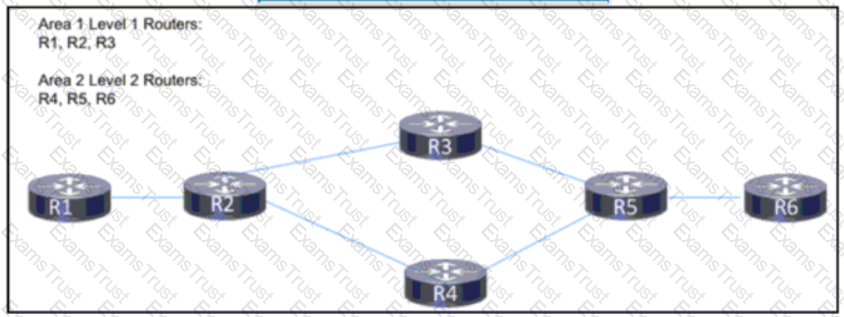
Which core component of MDT describes the data that an MDT-capable device streams to a collector?
After you analyze your network environment, you decide to implement a full separation model for Internet access and MPLS L3VPN services For which reason do you make this decision?
An engineer must apply an 802.1ad-compliant configuration to a new switchport with these requirements:
The switchport must tag all traffic when it enters the port.
The switchport is expected to provide the same level of service to traffic from any customer VLAN.
Which configuration must the engineer use?
Refer to the exhibit.
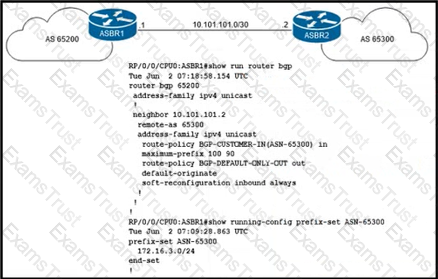
A network engineer is implementing a standard customer route-policy on ASBR1 with these requirements:
• It must accept only customer-assigned prefixes
• It must preserve customer advertised BGP communities
• It must set the local-preference to 110 for all prefixes
• It must attach the ORIGINATION-PE and LOCAL-CITY communities to all accepted prefixes.
Which route policy must the engineer implement on ASBR1 to satisfy the requirements?
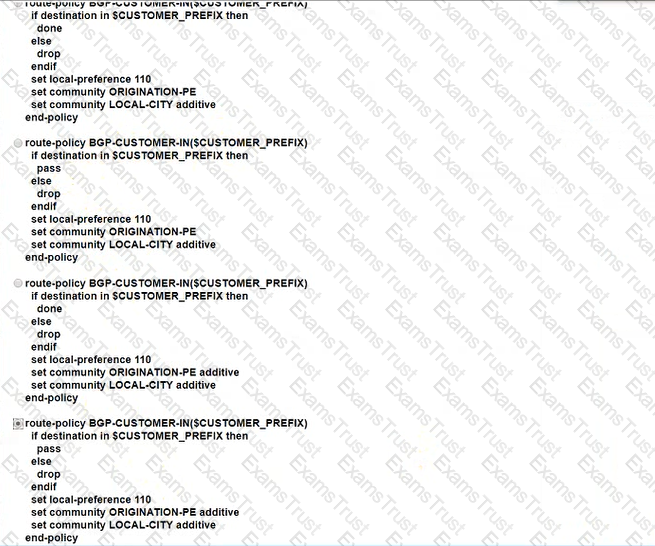
A network engineer is configuring a BGP route policy for the SUBNET prefix set. Matching traffic must be dropped, and other traffic must have its MED value set to 400 and community 4:400 added to the route. Which configuration must an engineer apply?
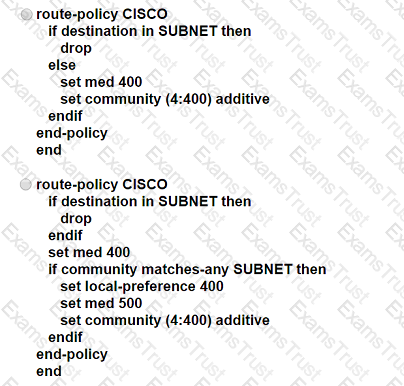
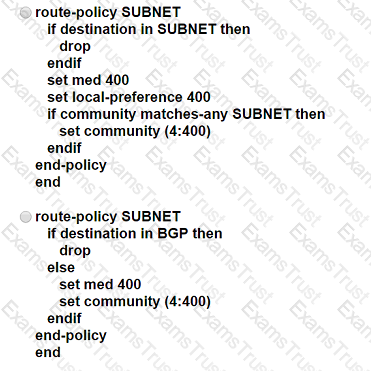
Refer to the exhibit.
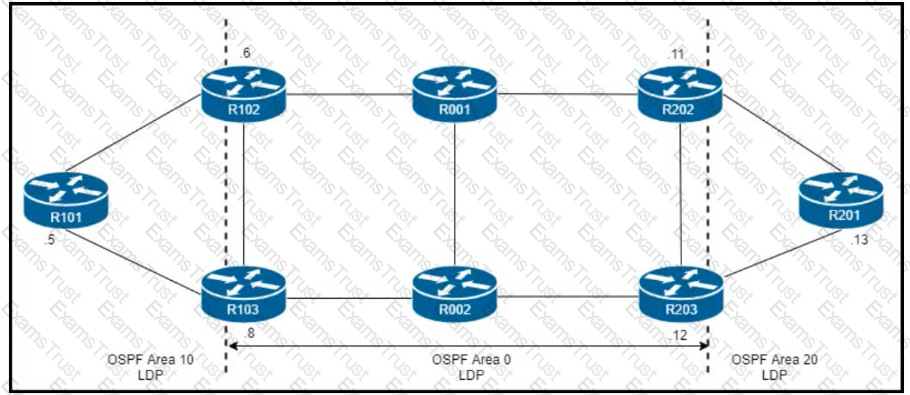
R101 is peering with R102 and R103, and R201 is peering with R202 and R203 using iBGP Labeled Unicast address families. The OSPF area 0 border routers are in a full iBGP Labeled Unicast mesh, and VPNv4 routes are exchanged directly between PE routers R101 and R201 through iBGP Which address family-level configuration must be applied on ABR R102 on ABR R102 to support a Unified MPLS routing architecture with partitioned IGP domains?
A)

B)
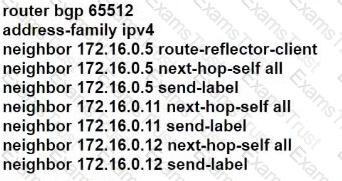
C)
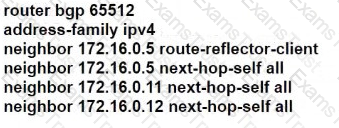
D)
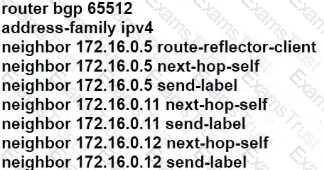
What is a characteristics of the Pipe model for MPLS QoS?
What is the role of NSO in network automation?
Which technology enables the addition of new wavelengths in a fiber-optic network?
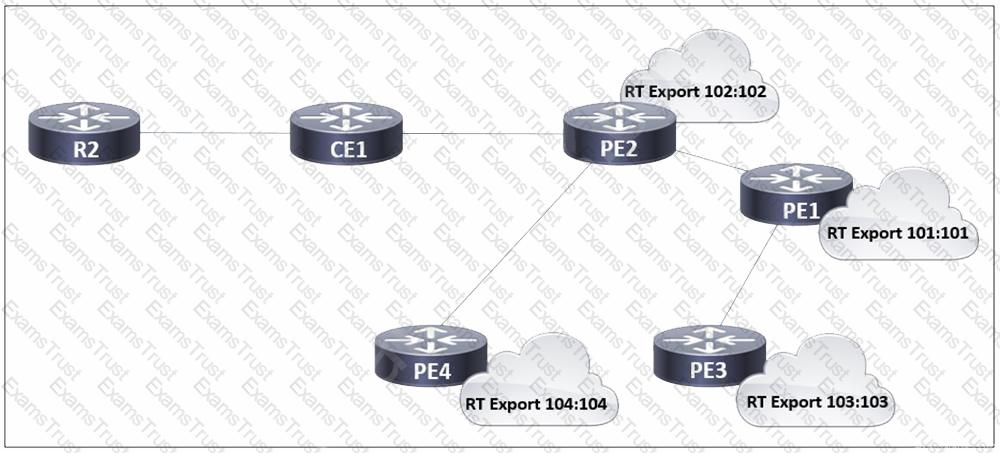
Refer to the exhibit. In the service provider network, routers PE1, PE2, and PE4 have access to the internet and provide access to customer networks. Router PE3 is used for access to other customer systems. In accordance with a new SLA, an engineer is updating settings on this network so that router CE1 accesses the internet via PE1 instead of PE2. Which two tasks must the engineer perform to complete the process? (Choose two.)
How does Inter-AS Option-A function when two PE routers in different autonomous systems are directly connected?
Which statement about the Cisco MPLS TE forwarding adjacency feature is true?
Which statement about segment routing prefix segments is true?
Refer to the exhibit.
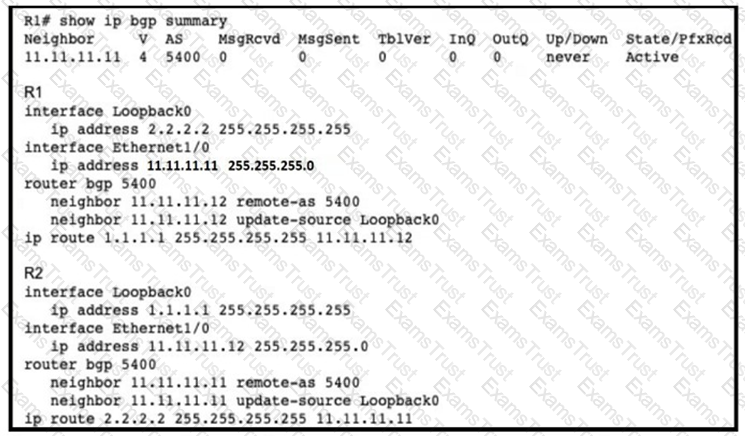
Router R1 is reporting that its BGP neighbor adjacency to router R2 is down, but its state is Active as shown. Which configuration must be applied to routers R1 and R2 to fix the problem?
A)
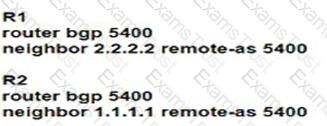
B)

C)
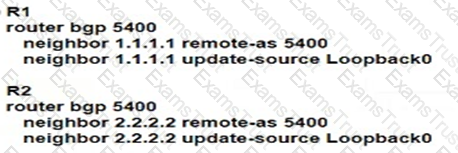
D)

Drag and drop the functionalities from the left onto the target fields on the right.
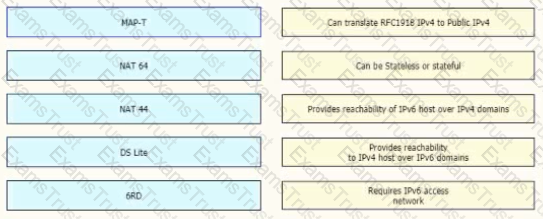
Refer to the exhibit.

An engineer applied a gRPC dial-in configuration on customer's router to provide connection multiplexing and two-way streaming. What does this configuration accomplish in a gRPC?
Refer to the exhibit.
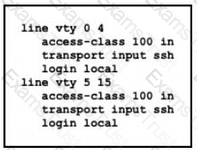
An engineer has started to configure a router for secure remote access as shown. All users who require network access need to be authenticated by the SSH Protocol.Which two actions must the engineer implement to complete the SSH configuration? (Choose two.)
Simulation2
TOPOLOGY
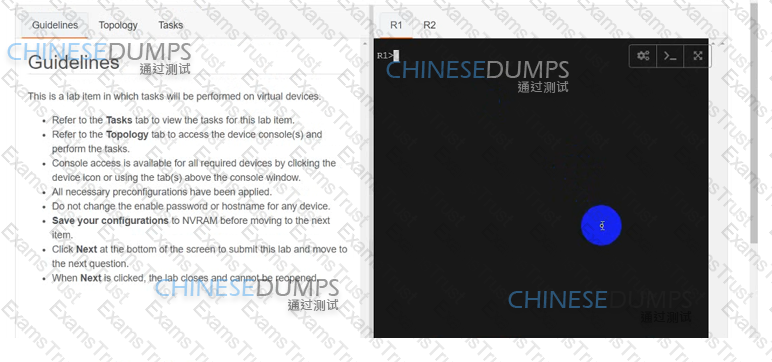
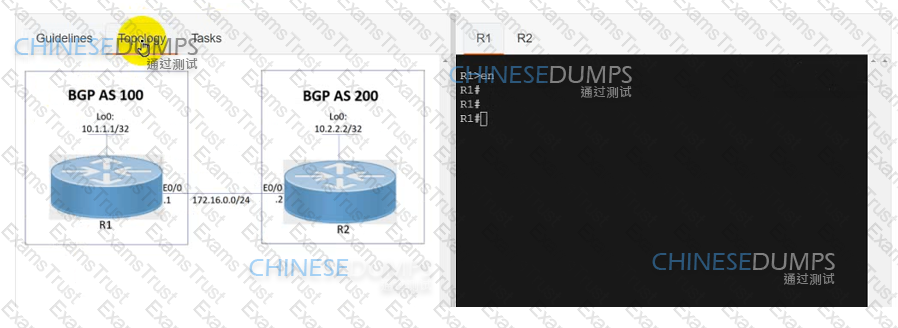
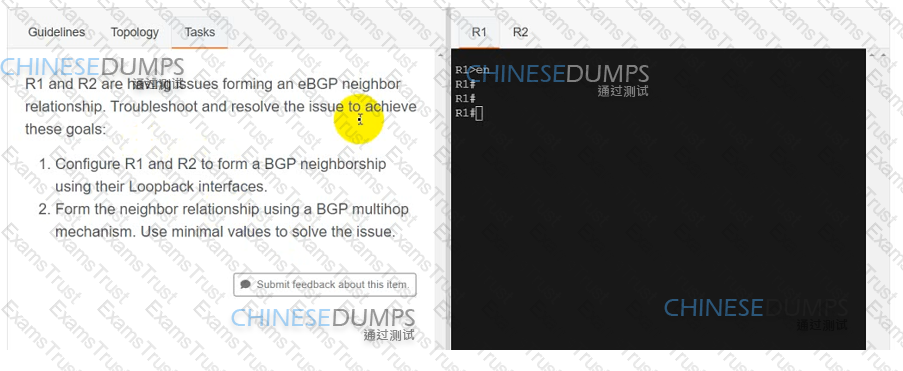
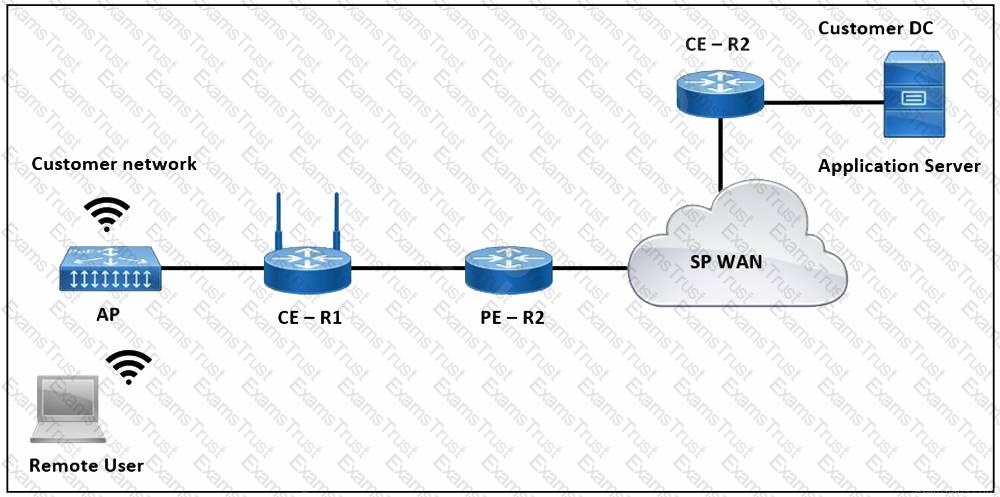
Refer to the exhibit. The application server in the data center hosts voice, video, and data applications over the internet. The data applications run more slowly than the voice and video applications. To ensure that all applications run smoothly, the service provider decided to implement a QoS policy on router PER 2 to apply traffic shaping. Which two actions must an engineer take to implement the task? (Choose two.)
Which two PHY modes are available to implement an IOS XR Gigabit Ethernet interface interface? (Choose two.)
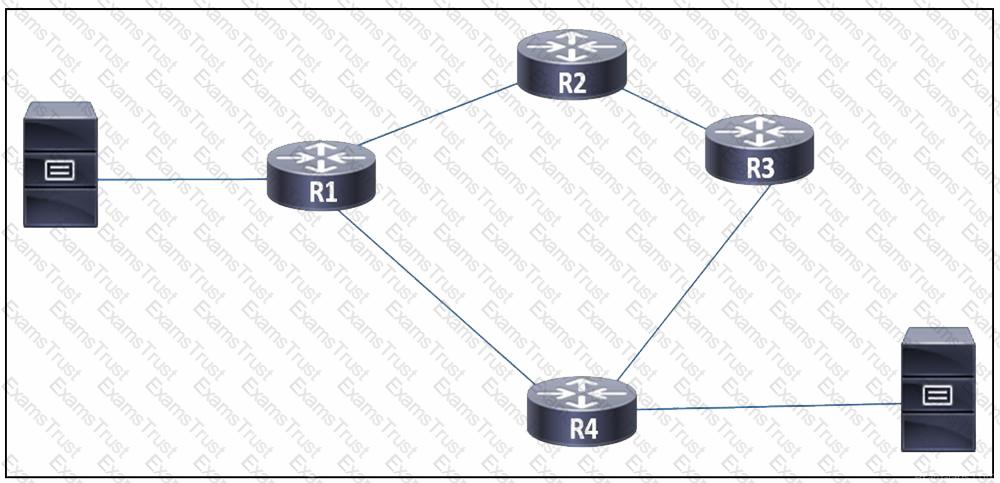
Refer to the exhibit. A network engineer observed congestion between routers R1 and R4, which are connected on a point-to-point link. Two servers that reside on networks on R1 and R4 generate heavy traffic between them with most traffic going from R4 to R1. To improve overall performance, the engineer wants to drop inbound packets that exceed a configured threshold, without disrupting traffic that passes from R4 to R3. Which action must the engineer take to resolve the issue?
A network operator needs to implement PIM-SSM multicast configuration on customer's network so that users in different domains are able to access and stream live traffic. Which two actions must the engineer perform on the network
to make the streaming work? (Choose two.)
An engineer working for a private telecommunication company with an employe id:3948:613 needs to limit the malicious traffic on their network. Which configuration must the engineer use to implement URPF loose mode on the GigabitEthernet0/1 interface?
A)

B)

C)

D)

A company is expanding its existing office space to a new floor of the building, and the networking team is installing a new set of switches. The new switches are running IGMPv2, and the engineers configured them for VLAN10 only. The rest of the existing network includes numerous Layer 2 switches in multiple other VLANs, all running IGMPv3. Which additional task must the team perform when deploying the new switches so that traffic is switched correctly through the entire network?

Guidelines
-
This is a lab item in which tasks will be performed on virtual devices.
• Refer to the Tasks tab to view the tasks for this lab item.
• Refer to the Topology tab to access the device console(s) and perform the tasks.
• Console access is available for all required devices by clicking the device icon or using the tab(s) above the console window.
• All necessary preconfigurations have been applied.
• Do not change the enable password or hostname for any device.
• Save your configurations to NVRAM before moving to the next item.
• Click Next at the bottom of the screen to submit this lab and move to the next question.
• When Next is clicked, the lab closes and cannot be reopened.
Topology
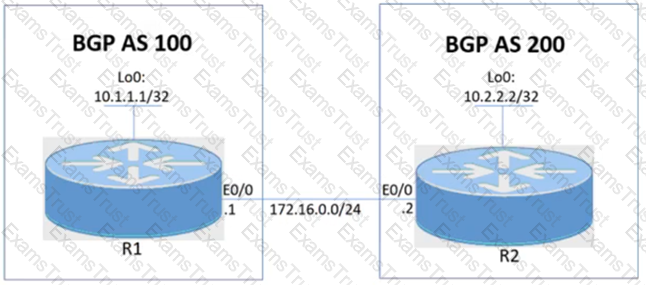
Tasks
-
R1 and R2 are having issues forming an eBGP neighbor relationship. Troubleshoot and resolve the issue to achieve these goals:
1. Configure R1 and R2 to form a BGP neighborship using their Loopback interfaces.
2. Form the neighbor relationship using a BGP multihop mechanism. Use minimal values to solve the issue.
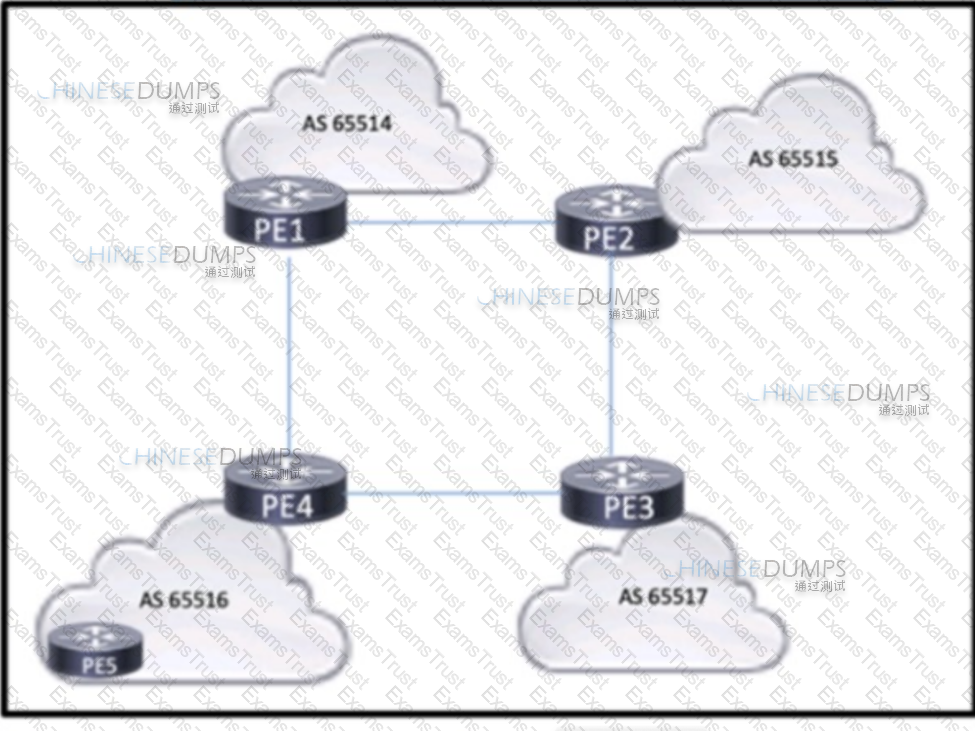
Refer to the exhibit. Four midsize service providers provide access to different customers that use Layer 3 VPN services to enable communication across geographic regions. The service providers are connected as shown in the exhibit, and the PEs have established eBGP relationships. PE4 has an IBGP relationship with PE5. The routes that PE4 learns from PE5 must reach the other PE routers, but they are absent from the routing tables on the other PES. Which action should the engineers take to correct the problem?
How is RSVP used with MPLS traffic engineering tunnels?
Why is the keyword none needed when implementing management plane security using TACACS?
An engineer is implementing IGMP with SSM on a multicampus network that supports video streaming. Which task must the engineer perform as part of the process?
An engineer implemented LDP protocol on the ISP network. The engineer must ensure that there are no packet loss issues when IGP and LDP protocols are not synchronized. Which configuring must the engineer implement so that the IGP routing protocol will wait until LDP convergence is completed?
Which utility can you use to locate MPLS faults?
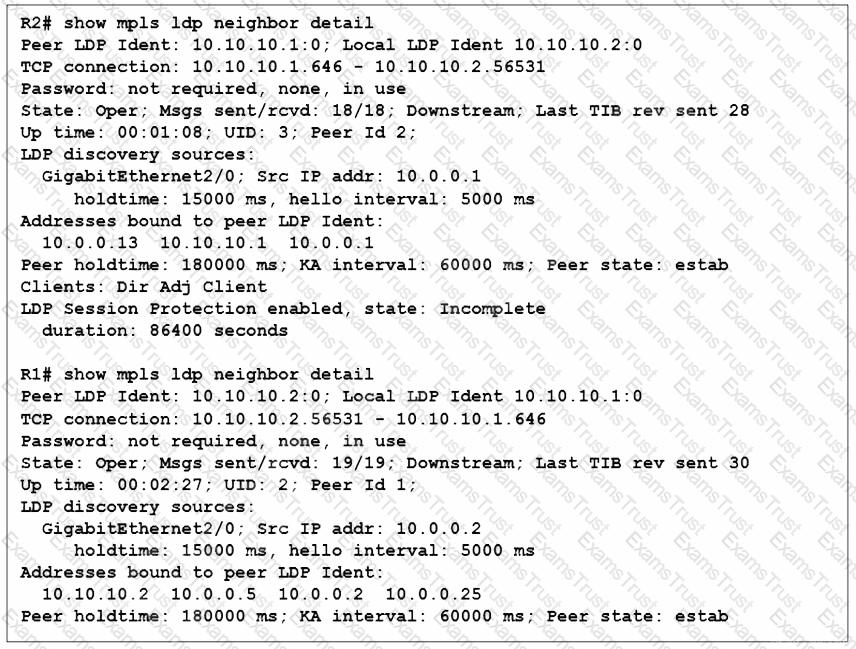
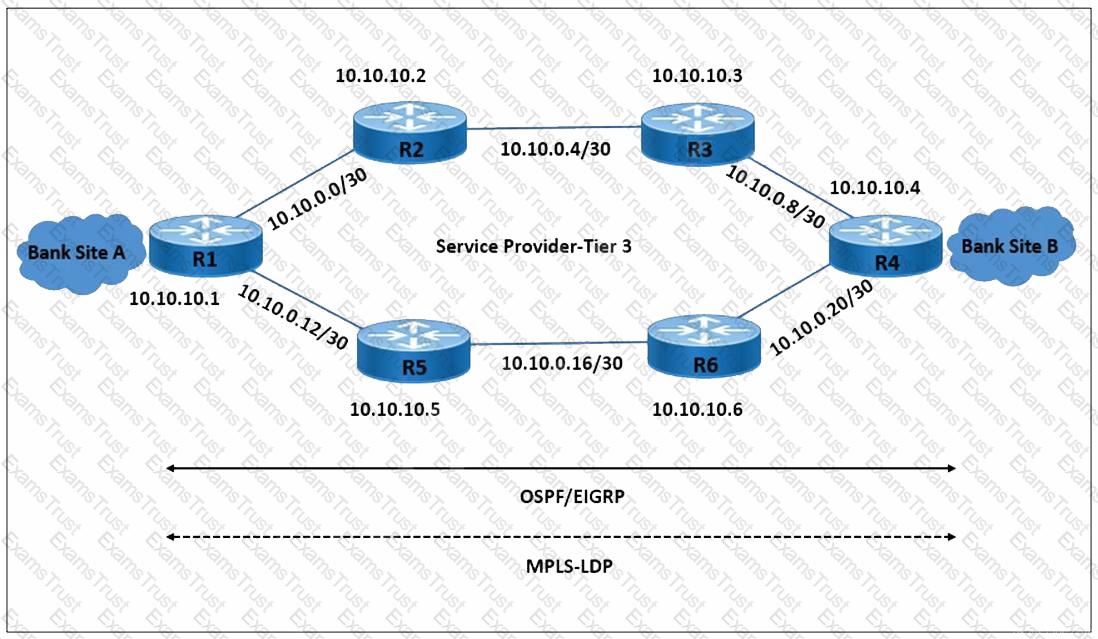
Refer to the exhibit. LDP peering between routers R1 and R2 is dropped when the link between R1 and R2 is taken offline. However, LDP peering between R2 and R3 stays up when the link between R2 and R3 is taken offline. Which action allows MPLS traffic forwarding to continue normally if the link between R1 and R2 goes down?
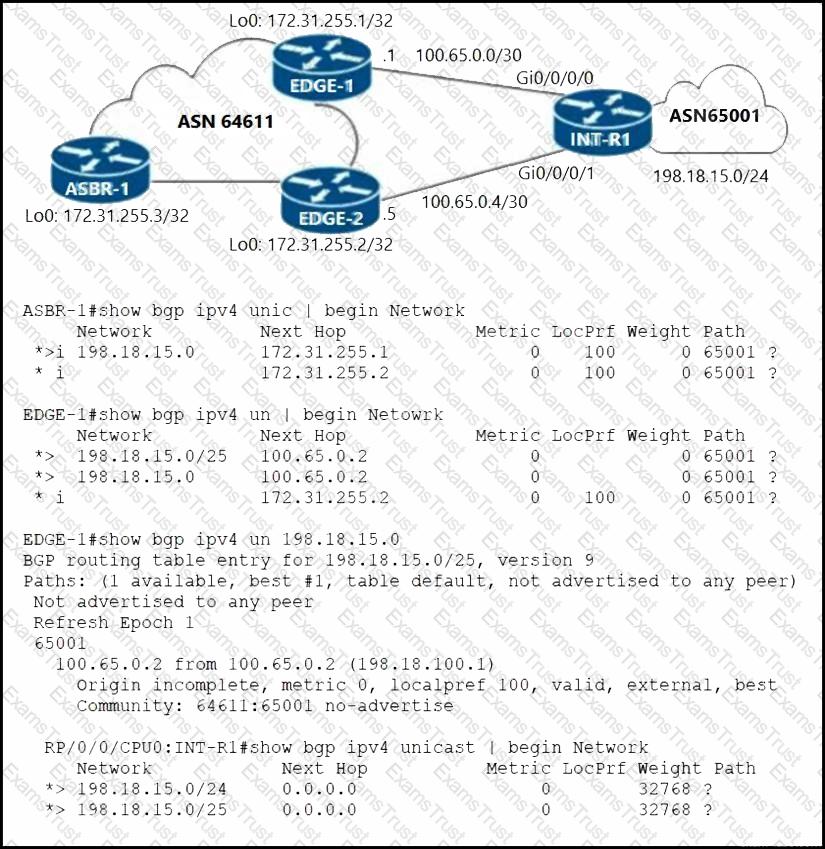
Refer to the exhibit. The network engineer who manages ASN 65001 is troubleshooting suboptimal routing to the 198.18.15.0/24 prefix. According to the network requirements:
Routing to IP destinations in the 198.18.15.0/25 block must be preferred via the EDGE-1 PE.
Routing to IP destinations in the 198.18.15.128/25 block must be preferred via the EDGE-2 PE.
More specific prefixes of the 198.18.15.0/24 block must not be advertised beyond the boundaries of ASN 64611.
Routing to 198.18.15.0/24 must be redundant in case one of the uplinks on INT-R1 fails.
Which configuration must the network engineer implement on INT-R1 to correct the suboptimal routing and fix the issue?
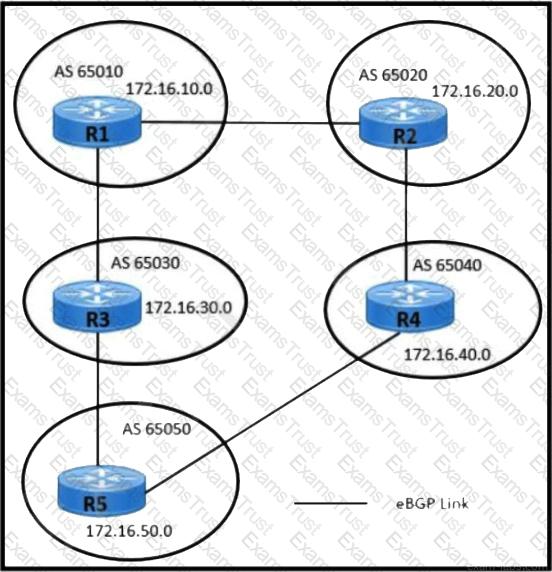
Refer to the exhibit. Users in AS 65010 are connected with the application server in AS 65050 with these requirements:
AS 65010 users are experiencing latency and congestion to connect with application server 172.16.50.10.
AS 65030 must be restricted to become Transient Autonomous System for traffic flow.
Links connected to AS 65020 and AS 65040 are underutilized and must be used efficiently for traffic.
Which two configurations must be implemented to meet these requirements? (Choose two.)
A network engineer is adding 10Gbps link to an existing 2X1Gbps LACP-based LAG to augment its capacity. Network standards require a bundle interface to be take out of service if one of its member links does down, and the new link must be added with minimal impact to the production network. Drag and drop the tasks that the engineer must perform from the left into the sequence on the right. Not all options are used.
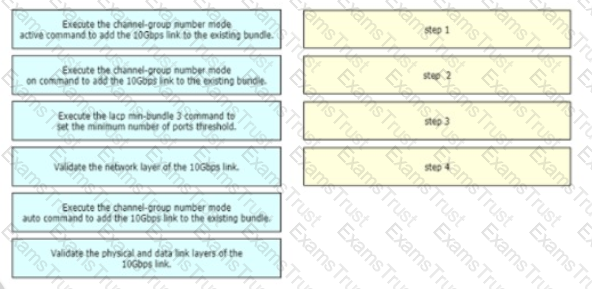
According to RFC5305 on IS-IS extensions for traffic engineering, what is the 4-octet sub-TLV type 10 of extended IS-IS reachability TLV type 22?
Refer to the exhibit.
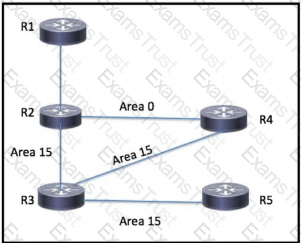
An engineer has started to configure a router for OSPF, as shown Which configuration must an engineer apply on the network so that area 15 traffic from R5 to R1 will prefer the route through R4?
Refer to the exhibit.

What reestablishes the OSPF neighbor relationship between Router 1 and Router 2?
Refer to the exhibit.

A network engineer is deploying SNMP configuration on client's routers. Encrypted authentication must be included on router 1 to provide security and protect message confidentially. Which action should the engineer perform on the routers to accomplish this task?
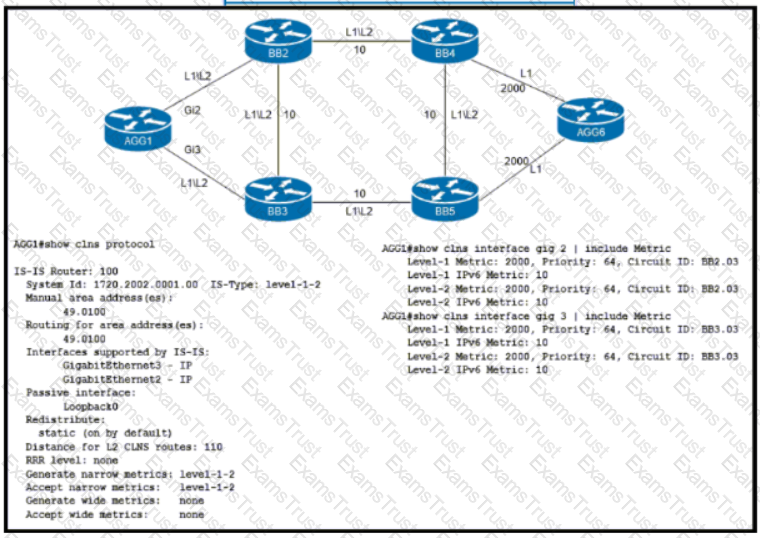
Refer to the exhibit. An engineer is configuring IS-IS on ISP network. Which IS-IS configuration must an engineer implement on router AGG1 so that it establishes connectivity to router AGG6 via the BB3 core router?
A regional MPLS VPN provider operates m two regions and wants to provide MPLS L 3VPN service for a customer with two sites in these separate locations. The VPN provider approaches another organization to provide backbone carrier services so that the provider can connect to these two locations.
Which statement about this scenario is true?
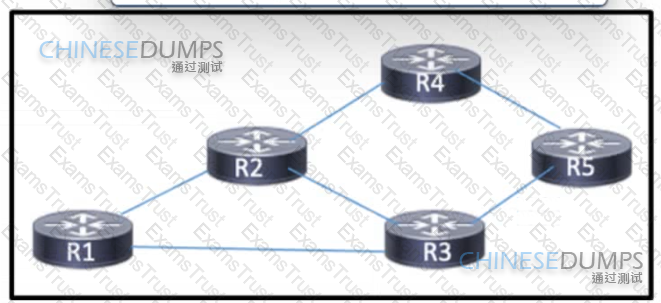
Refer to the exhibit. Routers R1 through R5 are being deployed within the core of a service provider running BGP The core supports distribution of VPNv4 routes using MPLS. R3 currently has multiple paths to reach R4. A network engineer must implement BGP attributes so that R3 can reach R4 via R1. Which action must the engineer take to meet the requirement?
Refer to the exhibit:
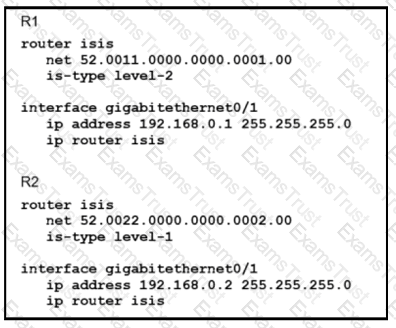
Which statement about the status of the neighbor relationship between R1 and R2 is true?
Which condition must be met for TI-LFA to protect LDP traffic?
Drag and drop the OSPF area types from the left onto the correct statements on the right

Refer to the exhibit:

P3 and PE4 are at the edge of the service provider core and serve as ABR routers Aggregation areas are on either side of the core.
Which statement about the architecture is true?
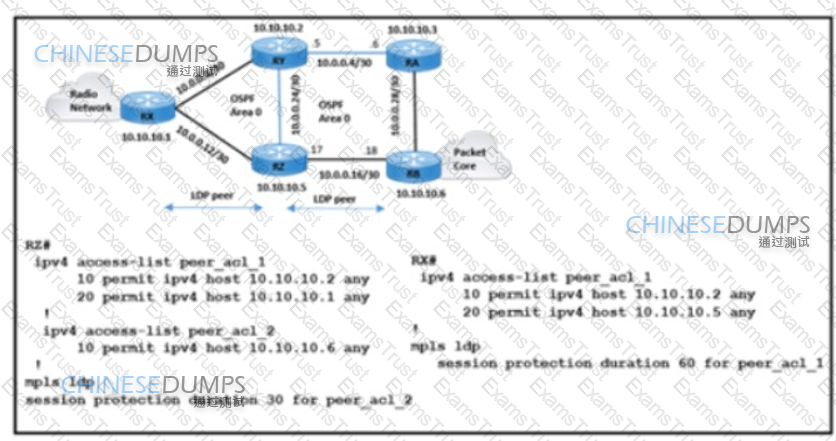
Refer to the exhibit. The radio network and packet core are using the route RX-RZ-RB to establish communication. The LDP session between 10.10.10.5 and 10.10.10.1 is experiencing link flapping at random intervals for 30-45 seconds each time. A network engineer must protect the LDP session and improve MPLS traffic convergence. Which action meets these requirements?
A remote operation center is deploying a set of l-BGP and E-BGP connections for multiple IOS-XR platforms using the same template. The l-BGP sessions exchange prefixes with no apparent issues, but the E-BGP sessions do not exchange routes. What causes this issue?
What is a feature of mVPN?
Refer to the exhibit.
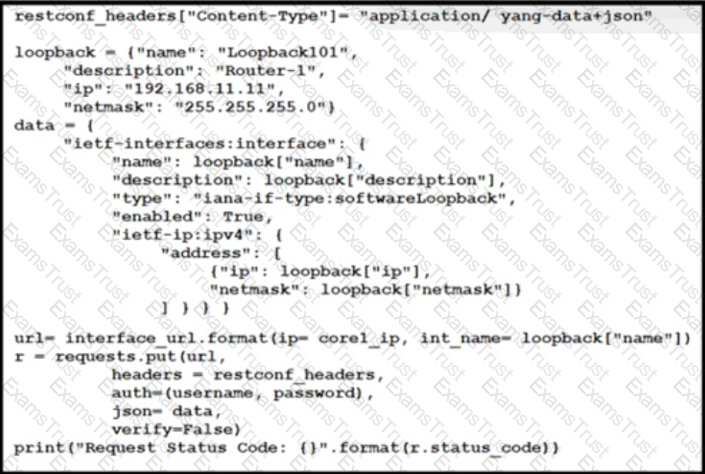
An engineer at a new ISP must configure many Cisco devices in the data center. To make the process more efficient, the engineer decides to automate the task with a REST API. Which action does this JSON script automate?
After a series of unexpected device failures on the network. a Cisco engineer is deploying NSF on the network devices so that packets continue to be forwarded during switchovers The network devices reside in the same holding, but they are physically separated into two different data centers Which task must the engineer perform as part of the deployment?
Which is the benefit of implementing model-driven telemetry in a service provider environment?
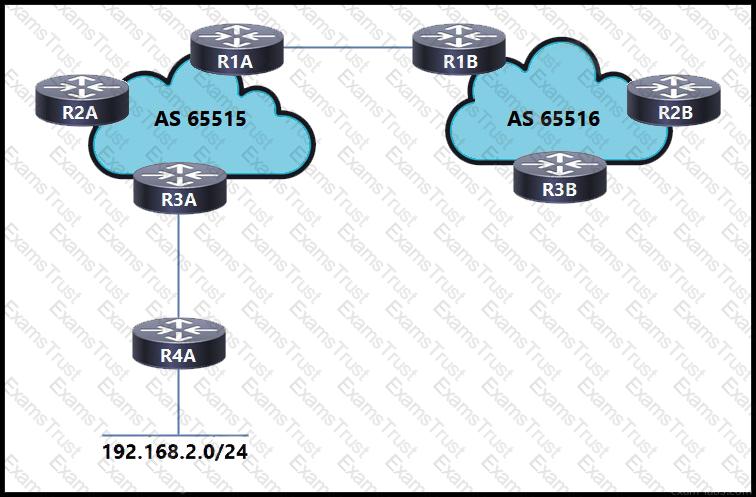
Refer to the exhibit. An engineer working for a private telecommunication company with an employee id: 3414:81:713 is implementing this network, in which:
Routers R1A and R1B are eBGP neighbors.
iBGP is configured within AS 65515 and AS 65516.
Network 192.168.2.0/24 is shared with AS 65516.
Router R3A has an iBGP relationship with router R2A only.
Router R2A has an iBGP relationship with routers R1A and R3A.
Which additional task must the engineer perform to complete the configuration?
What occurs when a high bandwidth multicast stream is sent over an MVPN using Cisco hardware?
How can shared services in an MPLS Layer 3 VPN provide Internet access to the customers of a central service provider?
Refer to the exhibit:

What does the REST API command do?
Refer to the exhibit.
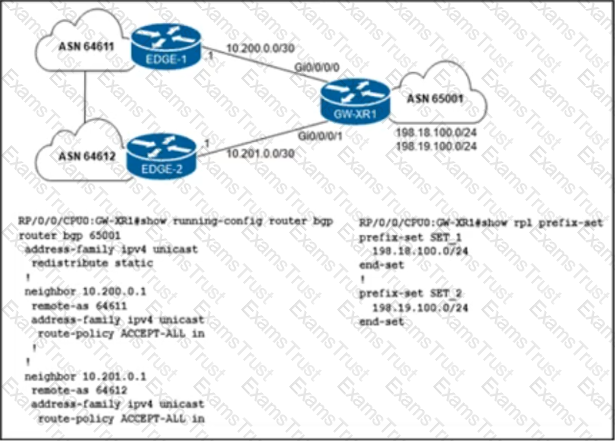
The network engineer who manages ASN 65001 must configure a BGP routing policy on GW-XR1 with these requirements:
• Advertise locally-originated routes and /24 prefixes assigned within the 198.18.0.0/15 range. All other prefixes must be dropped.
• Reachability to 198.18.100.0/24 must be preferred via the EDGE-1 connection.
• Reachability to 198.19.100.0/24 must be preferred via the EDGE-2 connection.
Which configuration must the network engineer implement on GW-XR1?
Refer to the exhibit:

R1 and R2 are directly connected with Fast Ethernet interfaces and have the above configuration applied OSPF adjacency is not formed. When the debug ip ospf hello command is issued on R1. these log messages are seen.

Which command can be configured on routers R1 and R2 on fO/O interfaces to form OSPF adjacency?
Exhibit:
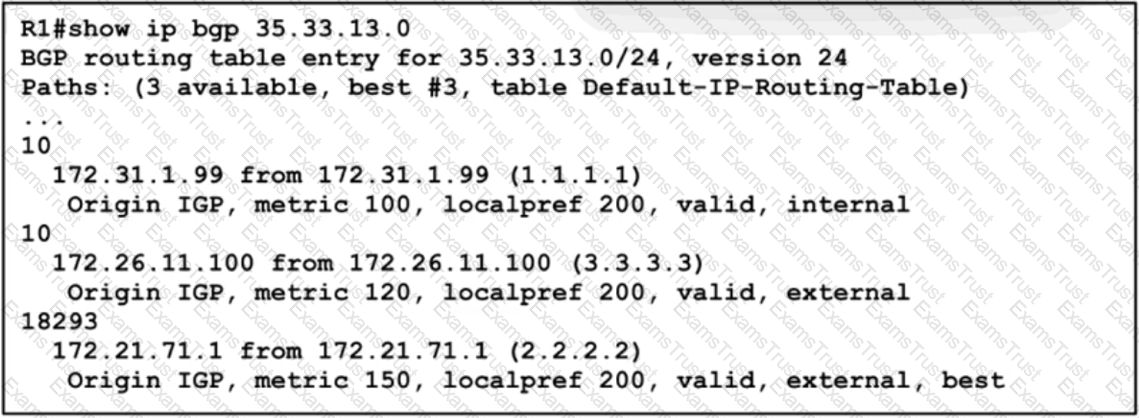
A network engineer must update the routing toward the web server with IP address 35.22.13.1. The primary path must be configured via the neighbor router with ID 1.1.1.1. However, local-preference configuration is not permitted on R1. Which task must the engineer perform on R1 to complete the implementation?
Refer to the exhibit.
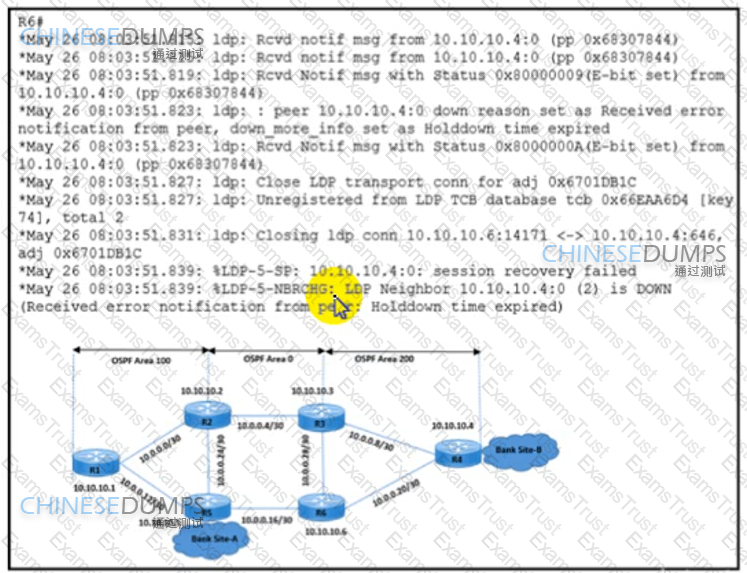
A network engineer is implementing an LDP-based MPLS solution to enable packet flow between the two bank sites The engineer was given two requirements
·LDP peering must stay up when there is a link failure between R3 and R6
·LDP peering must not flap when there is a link failure between R5 and R6
Which action meets these requirements?
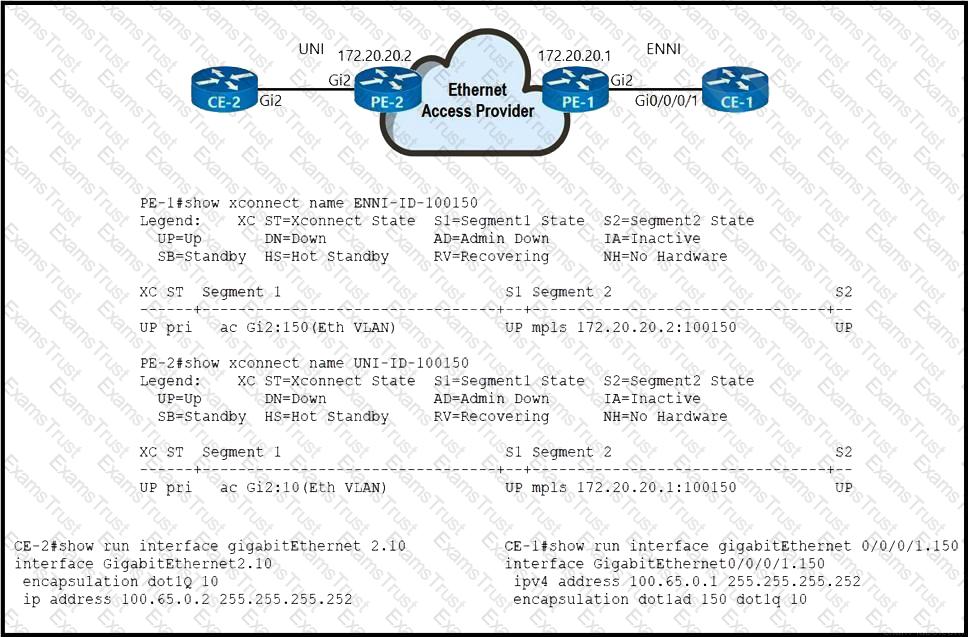
Refer to the exhibit. An Ethernet access provider is configuring routers PE-1 and PE-2 to provide E-Access EVPL service between UNI and ENNI. ENNI service multiplexing is based on 802.1ad tag 150, and service-multiplexed UNI is based on 802.1q tag 10. Which EFP configurations must the provider implement on PE-1 and PE-2 to establish end-to-end connectivity between CE-1 and CE-2?
A network engineer is configuring Flexible NetFlow and enters these commands
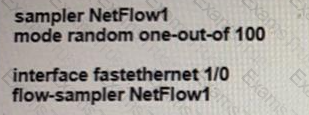
What are two results of implementing this feature instead of traditional NetFlow? (Choose two.)
Refer to the exhibit.

What does the number 2 mean in the configuration?
Which programmable API allows the service provider to plan and optimize the automation of network operations and achieve closed-loop operations?
A router is configured to perform MPLS LDP graceful restart.
Which three steps are included when the RP sends an LDP initialization to a neighbor to establish an LDP session? (Choose three)
Refer to the exhibit:
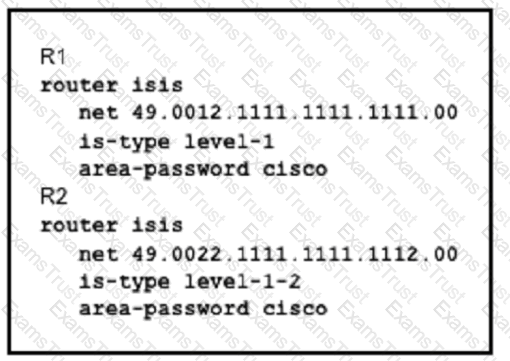
What is the effect of this configuration?
A network engineer must collect traffic statistics for an internal LAN toward the internet The sample must include the source and destination IP addresses, the destination ports, the total number of bytes from each flow using a 64-bit counter, and all transport flag information. Because of CPU limits, the flow collector processes samples that are a maximum of 20 seconds long. Which two configurations must the network engineer apply to the router? (Choose two.)
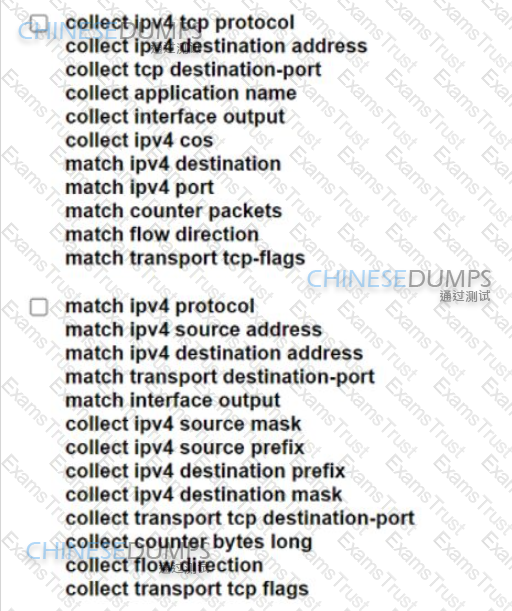
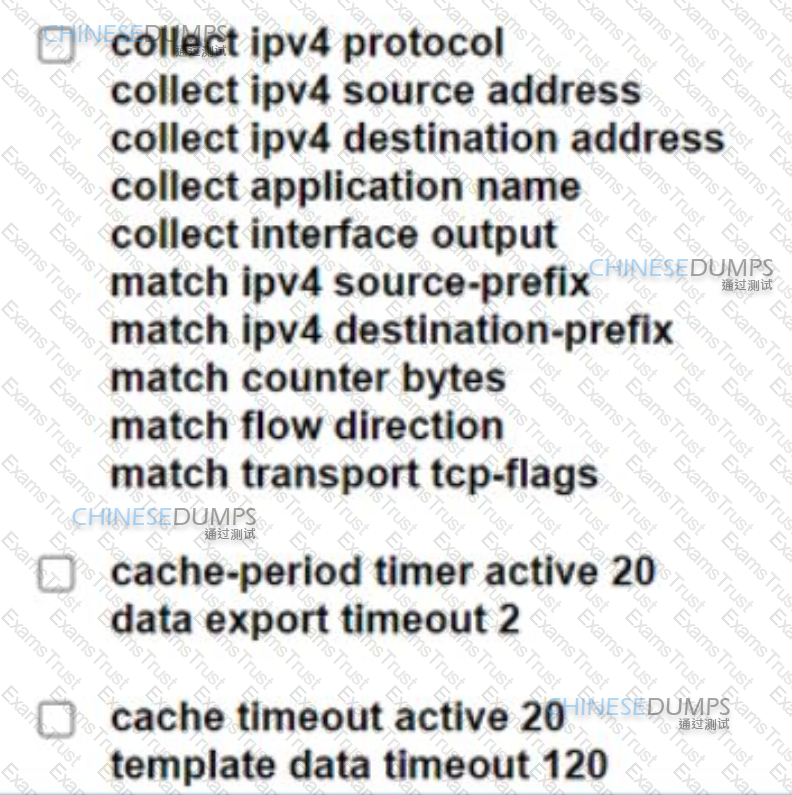
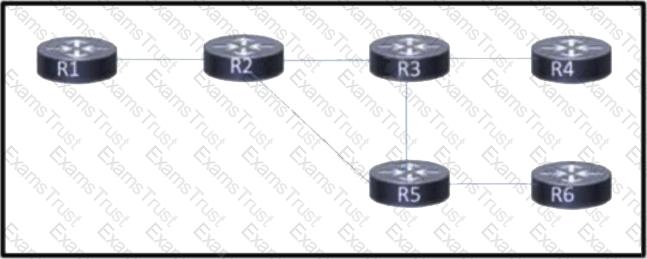
Refer to the exhibit. Customers report occasional forwarding issues from hosts connected to R6 to hosts connected to R1. A network engineer has just updated the MPLS configuration on the network, and a targeted LDP session has been established between R1 and R5. Which additional task must the engineer perform so that the team can identify the path from R6 to R1 in case the forwarding issues continue?
Refer to the exhibit.
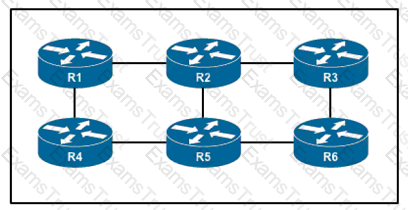
An engineer is configuring an administrative domain in the given multi-vendor environment with PIM-SM. Which feature must the engineer implement so that devices will dynamically learn the RP?
An engineer working for a telecommunication company with an employee ID: 4460:35:466 must configure an OSPF router in a multivendor network so that it performs NSF in the event of a route processor switchover. Which configuration must the engineer apply?
Refer to the exhibit.
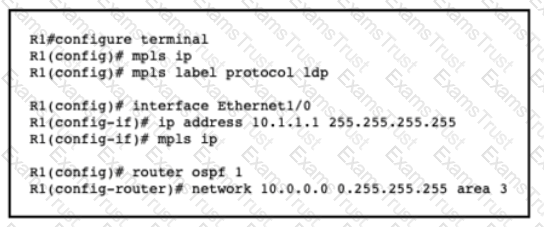
A network engineer is configuring MPLS LDP synchronization on router R1. Which additional configuration must an engineer apply to R1 so that it will synchronize to OSPF process 1?
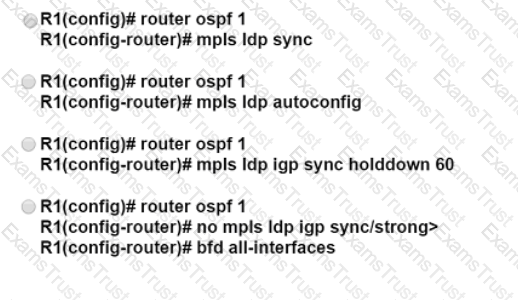
Refer to the exhibit:

A network administrator wants to enhance the security for SNMP for this configuration.
Which action can the network administrator implement?
Refer to the exhibit.

A network administrator is implementing IGMP to enable multicast feed transmission to the receiver. Which configuration must the administrator deploy on GW1 to permit IGMP Joins only to the assigned (S, G) feed?
A)
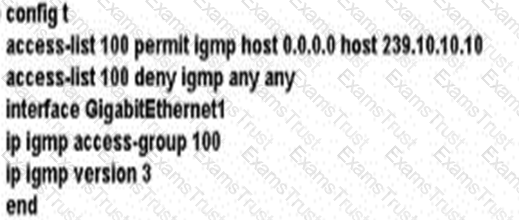
B)
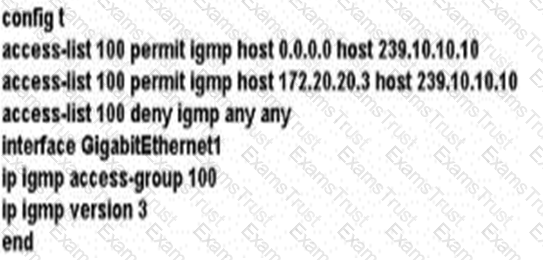
C)

D)
